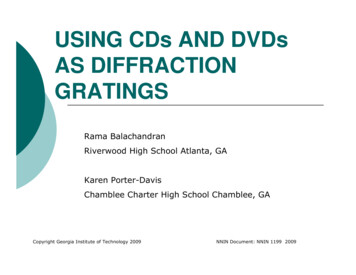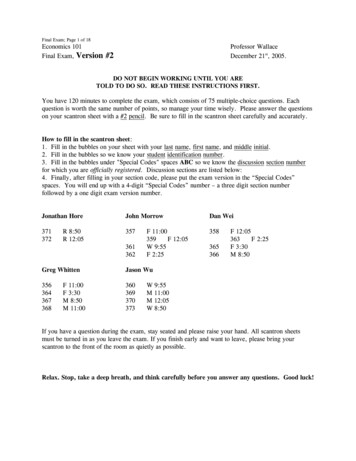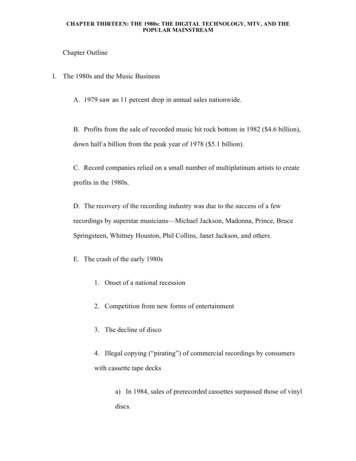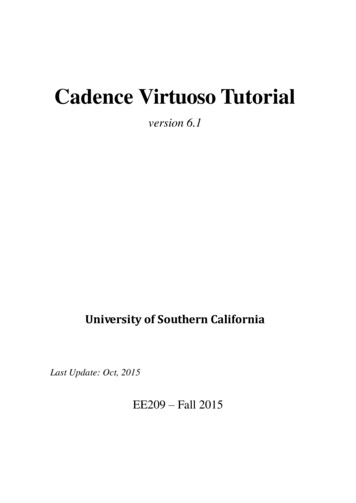
Transcription
USING CDs AND DVDsAS DIFFRACTIONGRATINGSRama BalachandranRiverwood High School Atlanta, GAKaren Porter-DavisChamblee Charter High School Chamblee, GACopyright Georgia Institute of Technology 2009NNIN Document: NNIN 1199 2009
Purpose of CDs and DVDs asDiffraction Gratings Activity{{{{Observe diffraction of light waves through aCD and DVDCDs and DVDs are well know to students sothey are likely to be interested in the laband participate in discussionEasy to transition into a discussion aboutcurrent technology and trends involvingdata storage devicesIncorporates nanotechnology by includingAFM (Atomic Force Microscope) images of aCD and DVD for the students to comparewith their macro-scale data
CDs and DVDs as DiffractionGratings{{{{CDs/DVDs display streaks of colors when white lightfalls on themThe digital information (alternating pits and smoothreflecting surfaces) stored on the discs form closelyspaced rows acting like a reflecting diffraction gratingThe rows do not reflect nearly as much light as theportions of the disc that separate themIn these portions the light reflected undergoesconstructive interference in certain directions.Therefore, when white light is reflected from the disceach wavelength of light can be seen at a particularangle with respect to the disc’s surface producing alight spectra
Creating Transmission Gratingsfrom a CD1: Scratch the label surface of the CD tobegin especially with painted labels(Blank CDs work best).2: Use Quik-stic or any other tape topeel off the label and reflecting layers.3: CD ready to use as transmissiondiffraction grating
Creating Transmission Gratingsfrom a DVD1: Use a razor blade tosplit the two layers ofthe DVD along the edge.2: Separate the twopolycarbonate layers3: Use Quik-stic or any othertape to peel off thereflecting layer.4: The transparent pieceacts as a transmissiongrating.
Experiment Set-up: DiffractionPatternCD gratingLasercentral spotscreen
Diffraction Images
Equations{{d (sinθ) mλm 0, 1, 2, d distance between slitsθ angle of diffractionλ wavelength of lightm the order # for the bright fringesTo find θ measure distance from grating to screenand the first order distance and then by usingtrigonometry calculate the angle.xθ tan-1(x/D)θθDθd
Calculations: CD and LaserEquation : dsinθ mλxavg 13.95 cmD 29.5 cmθ angle of diffraction tan-1 ( x/D)Æ tan-1(13.95/29.5) 25.3 m 1 (first order)λ 650 nm 10d (1)(650 E -9 m)/(sin 25.3 ) 1.52 μm
Calculations: DVD and LaserEquation : dsinθ mλxavg 42.5 cmD 20 cmθ angle of diffraction tan-1 ( x/D)Æ tan-1(42.5/20) 64.8 m 1 (first order)λ 650 nm 10d (1)(650 E -9 m)/(sin 64.8 ) 0.72 μm
AFM Image Measurements andComparisons of Track Pitch: CD and DVD{{{{{{CDAFM 1.57 μmCDCALC 1.52 μmCDACTUAL 1.6 μm (tolerance 0.1 μm)DVDAFM 0.797 μmDVDCALC 0.72 μmDVDACTUAL(4.7 GB) 0.74 μm
Experimental Results The grating element calculations from the diffractionpattern will agree very well with the spacingmeasured from analyzing the AFM images.The spacing of tracks in a DVD is about half as thatin a CD giving it twice as many tracks per mm. Thisaccounts for about a two fold gain in the capacity ofa DVD relative to CD.The average bit length and the data area of a DVDrelative to a CD gives it about a 3 fold gain and theother 2 fold gain comes from its improved errorcorrection procedures.
Atomic Force Microscope{{{Atomic Force Microscopes (AFMs) are devicesthat measure the surface topography of asample on a nanometer/micrometer scale andturn those measurements into an image.The basic principle behind the AFM is based onthe interaction between a probe (a sharp tipattached to a cantilever) and the atomicsurface of the sample.The forces on the tip can be attractive orrepulsive and cause the tip to deflect due to achange in these forces. This deflection isdetected by the reflection of a laser beamshone on the back surface of the cantilever.
AFMhttp://wills-nanotech.blogspot.com/2006 04 01 archive.html
Nanosurf easyScan 2 AFM System
AFM Images of CD and DVD(unrecorded)CD-BlankDVD- Blank(10 μm scan)(10 μm scan)Track pitch 1.57 μmTrack pitch 0.780 μm
AFM Images CD/DVD (recorded)CD - data encryptedscan size : 5 μmDVD – data encryptedscan size : 5 μm
Further Investigations{{{Obtain interference pattern withdouble layered DVD with the twolayers acting like double slits and useit to determine separation of theinformation layersInvestigate average data bit length inBlu-ray DVD relative to DVDUse light sensors and optical leversto investigate oscillating systemsCopyright Georgia Institute of Technology 2009NNIN Document: NNIN xxxx 2009
Purpose of CDs and DVDs as Diffraction Gratings Activity {Observe diffraction of light waves through a CD and DVD {CDs and DVDs are well know to students so










